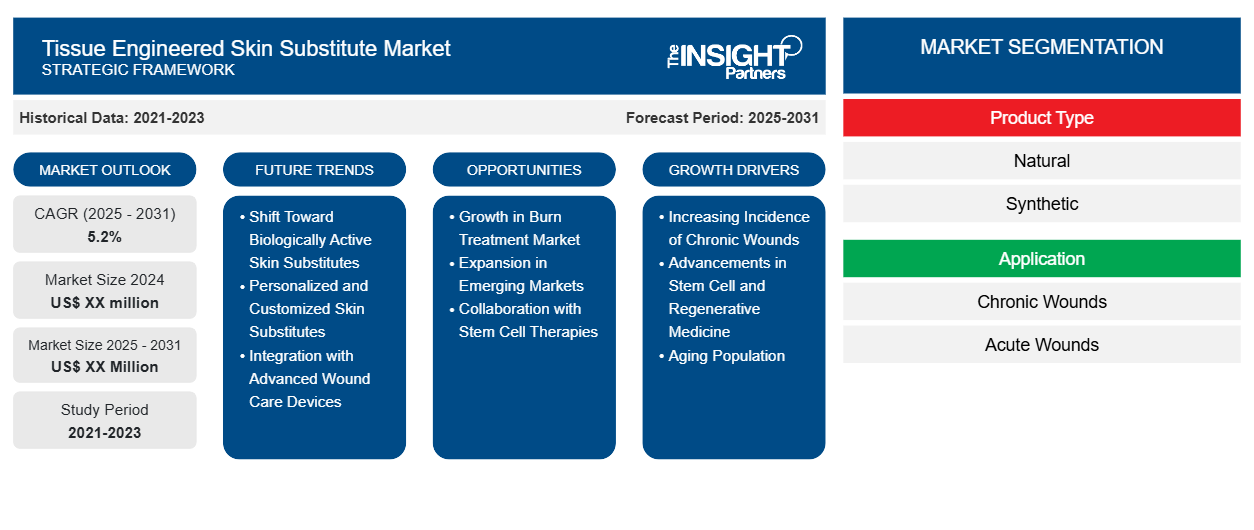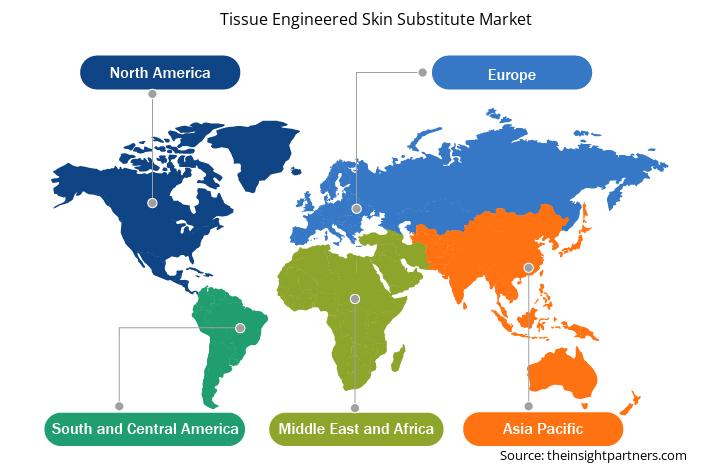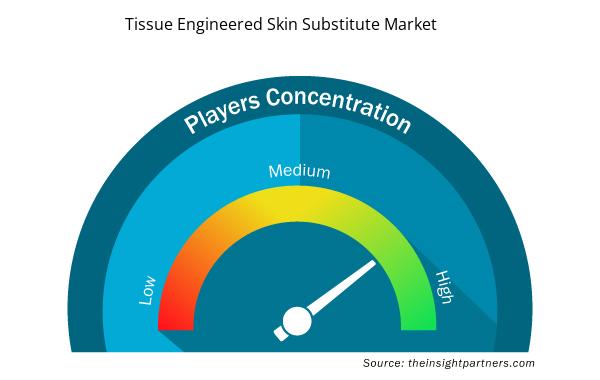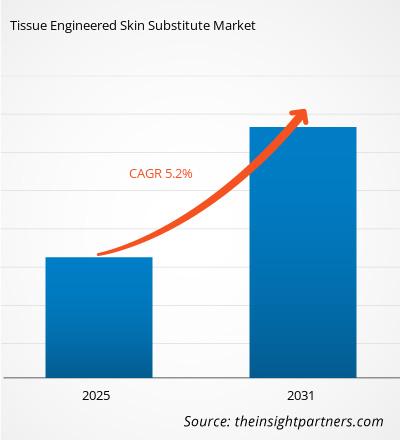The Tissue Engineered Skin Substitute Market is expected to register a CAGR of 5.2% from 2025 to 2031, with a market size expanding from US$ XX million in 2024 to US$ XX Million by 2031.
The report is segmented by Product Type (Natural, Synthetic). The report further presents analysis based on the Application (Chronic Wounds, Acute Wounds), End-User (Hospital and Clinic, Ambulatory Surgical Center, Others). The global analysis is further broken-down at regional level and major countries. The Report Offers the Value in USD for the above analysis and segments.
Purpose of the Report
The report Tissue Engineered Skin Substitute Market by The Insight Partners aims to describe the present landscape and future growth, top driving factors, challenges, and opportunities. This will provide insights to various business stakeholders, such as:
- Technology Providers/Manufacturers: To understand the evolving market dynamics and know the potential growth opportunities, enabling them to make informed strategic decisions.
- Investors: To conduct a comprehensive trend analysis regarding the market growth rate, market financial projections, and opportunities that exist across the value chain.
- Regulatory bodies: To regulate policies and police activities in the market with the aim of minimizing abuse, preserving investor trust and confidence, and upholding the integrity and stability of the market.
Tissue Engineered Skin Substitute Market Segmentation
Product Type
- Natural
- Synthetic
Application
- Chronic Wounds
- Acute Wounds
End-User
- Hospital and Clinic
- Ambulatory Surgical Center
Customize This Report To Suit Your Requirement
You will get customization on any report - free of charge - including parts of this report, or country-level analysis, Excel Data pack, as well as avail great offers and discounts for start-ups & universities
Tissue Engineered Skin Substitute Market: Strategic Insights

- Get Top Key Market Trends of this report.This FREE sample will include data analysis, ranging from market trends to estimates and forecasts.
Tissue Engineered Skin Substitute Market Growth Drivers
- Increasing Incidence of Chronic Wounds: The rising prevalence of chronic wounds, such as diabetic foot ulcers, venous leg ulcers, and pressure ulcers, is a key driver for the tissue engineered skin substitute market. These conditions require advanced treatment options, such as engineered skin substitutes, which provide an efficient way to promote healing and improve patient outcomes.
- Advancements in Stem Cell and Regenerative Medicine: Advancements in stem cell technology and regenerative medicine have led to the development of highly effective tissue-engineered skin substitutes. These innovations provide better wound healing and skin regeneration capabilities, addressing the limitations of traditional wound care products and driving market growth.
- Aging Population: The aging population is a major factor contributing to the growth of the tissue-engineered skin substitute market. Older adults are more susceptible to chronic wounds and other skin-related health issues, creating a growing need for effective tissue substitutes that can enhance recovery and improve the quality of life.
Tissue Engineered Skin Substitute Market Future Trends
- Shift Toward Biologically Active Skin Substitutes: There is a growing trend towards biologically active skin substitutes that promote tissue regeneration rather than simply providing a physical barrier. These products are increasingly used for chronic wound care, as they stimulate natural healing processes and improve outcomes, making them more desirable than traditional wound dressings.
- Personalized and Customized Skin Substitutes: Personalization of skin substitutes to match the patient's unique genetic profile or tissue type is gaining traction. Customized solutions offer better integration with the patient's skin and improve the success rate of treatments. This trend towards personalized wound care is expected to continue growing as technology advances.
- Integration with Advanced Wound Care Devices: The integration of tissue-engineered skin substitutes with advanced wound care devices, such as negative pressure wound therapy (NPWT) systems, is a key trend. This combination improves the healing process by providing a conducive environment for skin regeneration and accelerating wound closure.
Tissue Engineered Skin Substitute Market Opportunities
- Growth in Burn Treatment Market: The increasing incidence of burn injuries and the demand for effective burn treatment solutions present a significant opportunity for tissue-engineered skin substitutes. These substitutes offer an advanced alternative to traditional burn care, providing quicker and more effective healing for patients with severe burns.
- Expansion in Emerging Markets: Emerging markets, especially in Asia-Pacific and Latin America, present substantial growth opportunities. Improving healthcare infrastructure, rising awareness, and increasing access to advanced treatments are contributing to the rising adoption of tissue-engineered skin substitutes in these regions.
- Collaboration with Stem Cell Therapies: Collaborating with stem cell-based therapies for skin regeneration offers significant market potential. Combining tissue-engineered substitutes with stem cell technologies can improve healing efficiency and help regenerate skin with minimal scarring, offering a new frontier in wound healing.
Tissue Engineered Skin Substitute Market Regional Insights
The regional trends and factors influencing the Tissue Engineered Skin Substitute Market throughout the forecast period have been thoroughly explained by the analysts at Insight Partners. This section also discusses Tissue Engineered Skin Substitute Market segments and geography across North America, Europe, Asia Pacific, Middle East and Africa, and South and Central America.

- Get the Regional Specific Data for Tissue Engineered Skin Substitute Market
Tissue Engineered Skin Substitute Market Report Scope
| Report Attribute | Details |
|---|---|
| Market size in 2024 | US$ XX million |
| Market Size by 2031 | US$ XX Million |
| Global CAGR (2025 - 2031) | 5.2% |
| Historical Data | 2021-2023 |
| Forecast period | 2025-2031 |
| Segments Covered |
By Product Type
|
| Regions and Countries Covered | North America
|
| Market leaders and key company profiles |
Tissue Engineered Skin Substitute Market Players Density: Understanding Its Impact on Business Dynamics
The Tissue Engineered Skin Substitute Market market is growing rapidly, driven by increasing end-user demand due to factors such as evolving consumer preferences, technological advancements, and greater awareness of the product's benefits. As demand rises, businesses are expanding their offerings, innovating to meet consumer needs, and capitalizing on emerging trends, which further fuels market growth.
Market players density refers to the distribution of firms or companies operating within a particular market or industry. It indicates how many competitors (market players) are present in a given market space relative to its size or total market value.
Major Companies operating in the Tissue Engineered Skin Substitute Market are:
- Acelity (KCI)
- Integra LifeSciences
- Smith & Nephew
- Mimedx Group
- Organogenesis
- Vericel Corporation
Disclaimer: The companies listed above are not ranked in any particular order.

- Get the Tissue Engineered Skin Substitute Market top key players overview
Key Selling Points
- Comprehensive Coverage: The report comprehensively covers the analysis of products, services, types, and end users of the Tissue Engineered Skin Substitute Market, providing a holistic landscape.
- Expert Analysis: The report is compiled based on the in-depth understanding of industry experts and analysts.
- Up-to-date Information: The report assures business relevance due to its coverage of recent information and data trends.
- Customization Options: This report can be customized to cater to specific client requirements and suit the business strategies aptly.
The research report on the Tissue Engineered Skin Substitute Market can, therefore, help spearhead the trail of decoding and understanding the industry scenario and growth prospects. Although there can be a few valid concerns, the overall benefits of this report tend to outweigh the disadvantages.
- Historical Analysis (2 Years), Base Year, Forecast (7 Years) with CAGR
- PEST and SWOT Analysis
- Market Size Value / Volume - Global, Regional, Country
- Industry and Competitive Landscape
- Excel Dataset



Report Coverage
Revenue forecast, Company Analysis, Industry landscape, Growth factors, and Trends

Segment Covered
This text is related
to segments covered.

Regional Scope
North America, Europe, Asia Pacific, Middle East & Africa, South & Central America

Country Scope
This text is related
to country scope.
Frequently Asked Questions
The key drivers include the increasing prevalence of chronic wounds, advancements in stem cell and regenerative medicine, and the aging population, all of which create a demand for advanced skin substitutes.
Technological advancements in stem cell therapy, regenerative medicine, and biologically active substitutes are improving the effectiveness of skin substitutes, reducing healing times, and leading to better patient outcomes, which drives market adoption.
Challenges include high production costs, regulatory hurdles, and the complexity of manufacturing personalized solutions. Additionally, ensuring the consistency and safety of tissue-engineered products is crucial for market acceptance.
Emerging markets in Asia-Pacific, Latin America, and Africa offer significant growth potential due to improving healthcare systems, rising disposable incomes, and increasing demand for advanced wound care solutions.
Tissue-engineered skin substitutes play a critical role in wound healing by providing an effective solution for chronic and burn wounds, promoting tissue regeneration, and improving recovery times compared to traditional wound care products.
The market is expected to grow significantly, driven by technological advancements, increasing incidences of chronic wounds, and rising demand for personalized and biologically active substitutes. The market will continue to benefit from innovations in stem cell-based therapies and regenerative medicine.
Trends and growth analysis reports related to Life Sciences : READ MORE..
- Acelity (KCI)
- Integra LifeSciences
- Smith & Nephew
- Mimedx Group
- Organogenesis
- Vericel Corporation
- AlloSource
- Cellular Biomedicine Group
- Medline Industries
- Molnlycke Health Care

 Get Free Sample For
Get Free Sample For